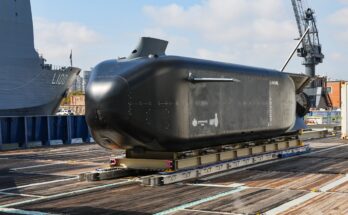by Stuart Slade, Senior Naval & Marine Power Systems Analyst, Forecast International.
The first ballistic missiles to be deployed on board warships were installed on diesel-electric submarines of the Soviet Project 611 (NATO Codename Zulu) class. These converted boats were succeeded by purpose-built designs, but the whole concept of a diesel-electric ballistic missile submarine (SSB) fell out of favor when the advent of nuclear power for submarines offered a more advantageous design solution. The SSBN has become the standard of great power – if a country’s navy operates SSBNs, that country qualifies as a great power. If it doesn’t, then it cannot claim great power status. The older SSB has fallen into disuse and for the last 40 years had been little more than an obscure footnote to history. During the last two years, this has significantly changed.
China led the way back to SSB construction with a pair of Project 032 SSBs derived from the country’s standard Project 041 Yuan class diesel-electric submarines. The precise role of these two boats remains unclear, with opinions ranging from them acting as test platforms for ballistic missile development to them being prototypes for a production class of SSBs intended for regional power projection.
They were followed by North Korea first testing a submarine-launched ballistic missile and then starting construction of an SSB to carry it. The North Korean SSBs appear much less sophisticated than the Chinese subs and apparently carry only a single missile. Presumably larger boats with a heavier armament will follow in due course. However, the existence of these North Korean SSBs was one factor leading to the South Korean decision to build a class of SSBs of its own – the Dosan Ahn Changho class. These 3,500-ton submarines have vertical launch tubes for six ballistic missiles. A developed version of the design with a capacity for 10 missiles is already completing final design. Current plans are for the South Korean Navy to operate nine SSBs.
The reasoning behind the re-introduction of this category of warship is the need to establish a viable deterrent capability in the face of nuclear-armed opponents and the parallel need to project power in regional waters. In South Korea, the growing probability that North Korea has a force of land-based nuclear-tipped ballistic missiles posed a major defensive problem. The short ranges from North Korean launch areas to South Korean cities meant that a “bolt-from-the-blue attack” would hit its targets before any reasonable defensive measures could be taken. The only real countermeasure to such an attack is to deter it. To make sure the deterrent force is secure means placing it at sea where a pre-emptive attack is very difficult.
The appeal of the SSB, a relatively inexpensive and easy-to-procure deterrent system for use in regional environments is spreading. Pakistan is believed to have approached China for the purchase of Project 032 class SSBs as a counter to the Indian Navy’s force of Arihant class SSBNs, It is hard to believe that other countries will not follow the same basic logic.
For 50 years, Forecast International intelligence reports have been the aerospace and defense industry standard for accurate research, analysis, and projections. Our experienced analysts compile, evaluate, and present accurate data for decision makers. FI's market research reports offer concise analysis of individual programs and identify market opportunities. Each report includes a program overview, detailed statistics, recent developments and a competitive analysis, culminating in production forecasts spanning 10 or 15 years. Let our market intelligence reports be a key part of reducing uncertainties and mastering your specific market and its growth potential. Find out more at www.forecastinternational.com




